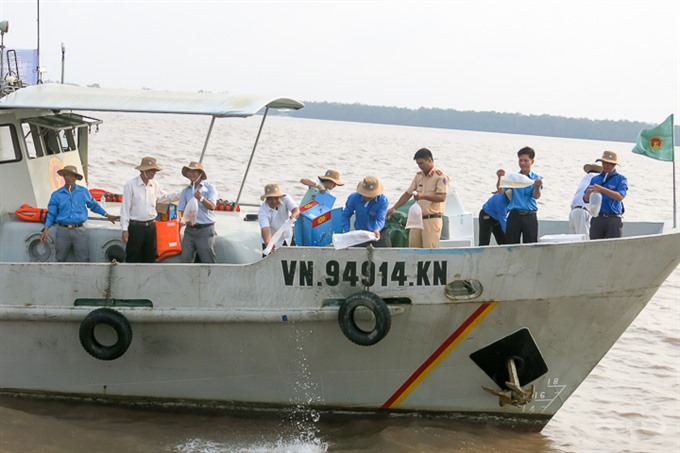 Society
Society

The Mekong Delta province of Sóc Trăng said it has achieved outstanding results in conserving fisheries resources by effectively preventing the use of banned fishing methods and increasing public awareness of the need for protecting fish stocks.
 |
| Local authorities and people release black-tiger shrimp juveniles into the sea in Sóc Trăng Province’s Trần Đề District to improve stocks. – Photo baosoctrang.org.vn |
SÓC TRĂNG – Authorities of Sóc Trăng said the Mekong Delta province has achieved outstanding results in conserving fisheries resources by effectively preventing the use of banned fishing methods and increasing public awareness of the need for protecting fish stocks.
It has organised more than 3,000 advocacy activities to enhance public awareness of the impacts of climate change on fisheries resources and the need for protecting those resources in the past five years, according to the local Department of Agriculture and Rural Development.
In the period the province also released more than 15 million black tiger shrimp juveniles and 1.4 million fry of various freshwater fish species into the sea and rivers.
It has adopted many fisheries conservation models like protecting aquatic species carrying eggs and establishing zones to protect breeding clams.
Activities that affect fisheries resources and the environment like using electricity and toxic chemicals to fish have been effectively checked.
Speaking at a meeting to review the efforts to protect and develop fish stocks in 2012-20 on Tuesday (Jan 8), Lê Văn Hiểu, deputy chairman of the province People’s Committee, said public awareness is the main factor in protecting fisheries resources.
“Advocating activities to enhance awareness among locals of fisheries resources protection and development should be strengthened.”
He said the department should completely prevent banned activities that deplete fish stocks.
Effective fisheries management models should be expanded to protect the livehoods of people living on the coast, he said.
Many households living near the coast derive their income mainly from fishing near shore since they do not have or have little farming land.
Effective models
The province has adopted many models that help protect fisheries resources and provide livelihoods for fishing households such as breeding aquatic species in mangrove forests, raising sea ducks, breeding shrimp and tilapia together, breeding goats for bearing kids, and making nylon bags.
These have improved incomes for fishing households and reduced fishing near shore.
Breeding obtuse horn shell, mangrove crab, mud clam, and mudskipper in mangrove forests in Cù Lao Dung District’s An Thạnh 3 and An Thạnh Nam communes fetches people high incomes.
Mã Văn Tùng, who with four other fishermen has been breeding aquatic species in a 1ha mangrove forest in An Thạnh 3 since 2017, said the model has enabled fishing households near the coast to switch livelihoods and is lucrative.
“[It] offers locals higher incomes than fishing near shore.”
It reduces the number of fishing trips to sea, thus helping marine protect fisheries resources, according to participating members.
The model also helps develop mangrove forests, which in turn improves fisheries resources.
Đỗ Văn Thừa, deputy head of the Cù Lao Dung Agriculture and Rural Development Division, said after adopting the various models, local fishermen’s awareness of fishing at sea has improved and they are no longer overfishing like before. – VNS




